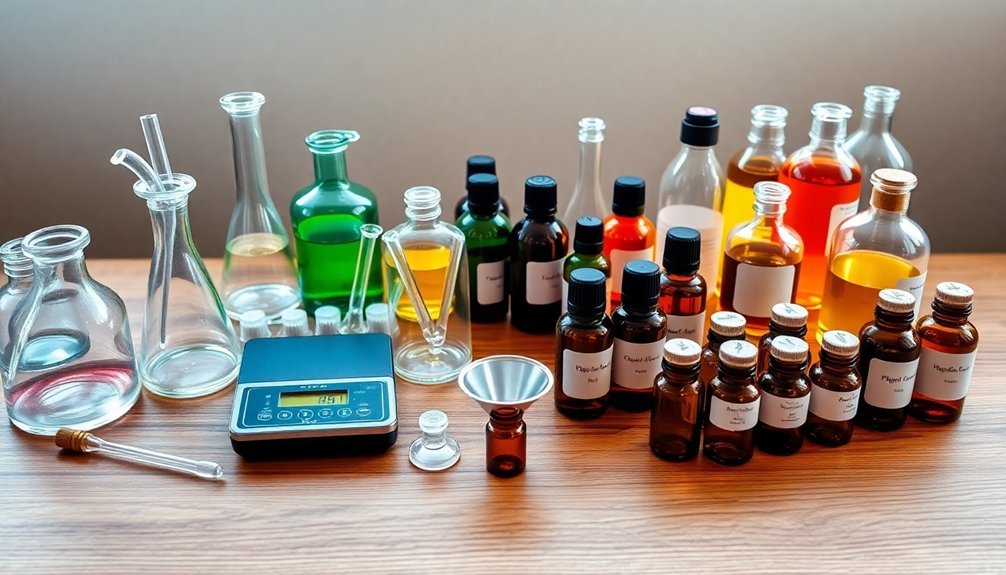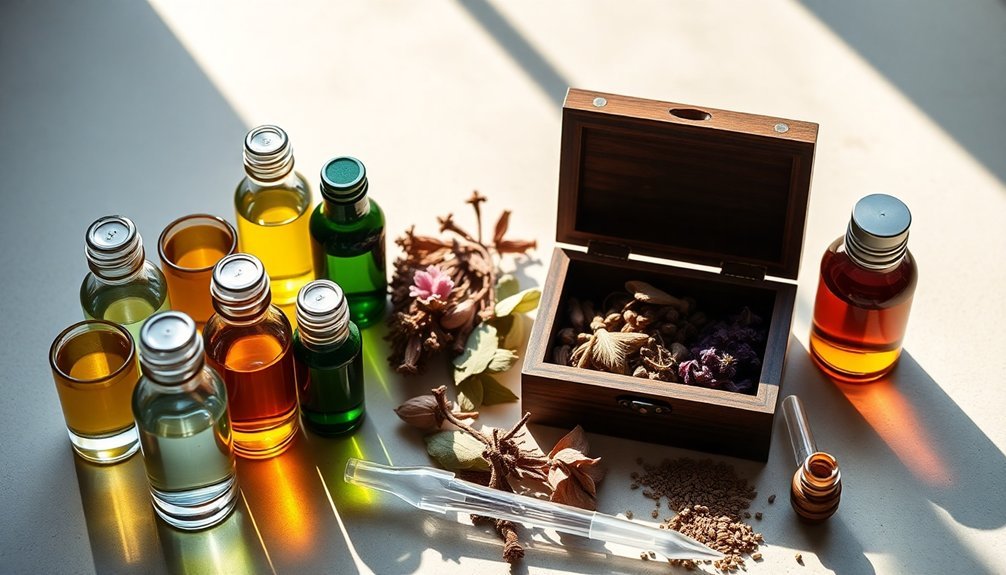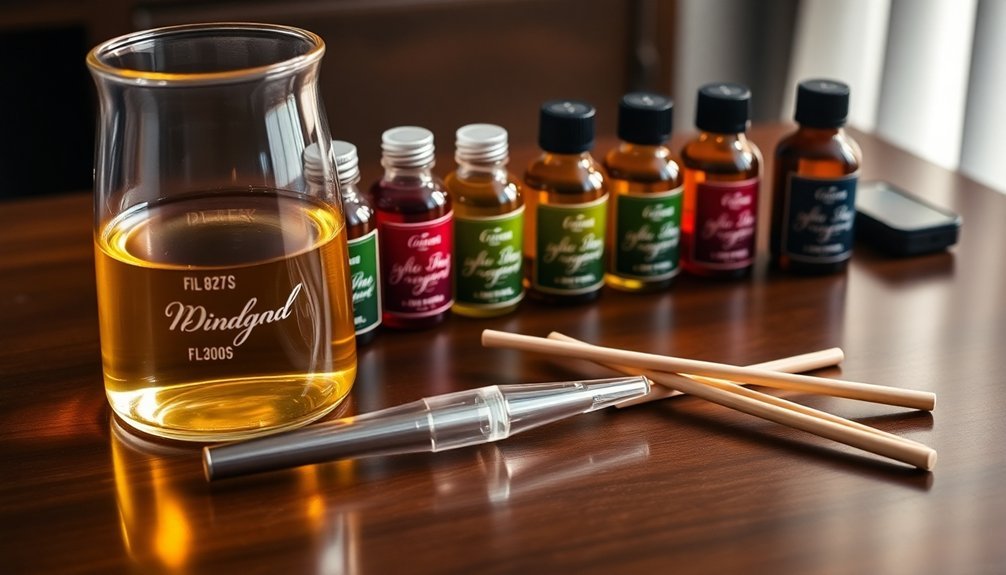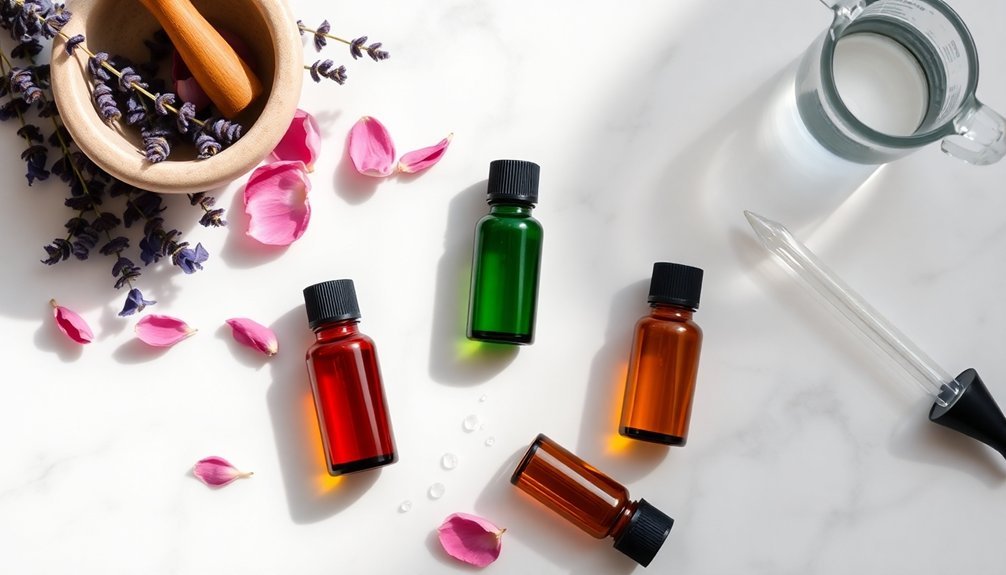You'll need several essential supplies to start making perfumes at home. Start with basic measuring tools like a digital scale (0.01g), droppers, and glass beakers for precise mixing. Gather protective equipment including safety goggles and chemical-resistant gloves. Stock up on essential oils, carrier oils, and perfumer's alcohol for your fragrances. Don't forget dark glass bottles for storage and smelling strips for testing. Understanding these fundamentals will help you create your first signature scent.
Essential Tools for Your First Perfume Kit

Four core categories of tools form the foundation of a beginner's perfume-making kit.
You'll need precise measuring tools, including a scale that measures to the hundredths and measuring spoons or droppers for accurate ingredient portions.
Glass containers are essential – stock up on beakers, cylinders, and dark glass bottles to protect your creations from light damage.
For transferring and filtering your perfumes, you'll want both glass and stainless steel funnels, along with strainers for filtering tinctures.
Don't forget the vital precision tools: pipettes for handling oils, monprene droppers for diluting aromatics, and wax-carving tools for thick substances like labdanum.
A thermometer helps monitor temperatures during the making process, while a stainless steel tray protects your work surface when you're filling bottles.
The carrier oils you select, such as jojoba or grapeseed, will serve as the base for diluting your essential oil blends.
Safety Equipment You Can't Skip
While perfume making is a creative pursuit, your safety should always come first.
You'll need essential protective gear including safety goggles to shield your eyes from splashes, chemical-resistant gloves to protect your skin, and a lab coat or apron to safeguard your clothing. Don't forget to wear closed-toe shoes.
Your workspace must be well-ventilated to prevent fume buildup. Keep a fire extinguisher nearby and make certain you have spill containment materials ready. Following proper SDS documentation guidelines is essential when working with specific chemicals.
Protect your work surfaces with appropriate covers and always use proper tools like glass beakers and metal spatulas for handling ingredients.
Be certain you're familiar with Safety Data Sheets for all your materials and label everything clearly.
Maintain a clean workspace and keep detailed records of your procedures.
These safety measures aren't optional – they're vital for responsible perfume making.
Basic Storage Solutions for Ingredients

Proper storage solutions form the backbone of successful perfume making.
You'll need a well-organized workspace with a three-tiered perfumery rack to store your dilutions at different concentrations (10%, 1%, 0.1%). Keep frequently used materials within arm's reach on your immediate workstation.
Consider arranging fragrances by natural ingredient groups to better understand how they interact when blending.
For bulk materials, opt for plastic A4-sized boxes instead of cardboard, as they provide better protection against vapors.
Label bottle lids with ingredient initials and use colored pens to indicate scent profiles. Dark glass containers are essential for protecting your fragrance oils from light degradation.
Don't forget to label each bottle with its contents and concentration.
Maintain detailed documentation of your ingredients, including where you purchased them and the results of your blending experiments.
Store everything in a cool, dark place away from humidity.
Must-Have Measuring Instruments
To create professional-grade perfumes, you'll need a precise set of measuring instruments that guarantee consistent results.
These tools will help you maintain accuracy throughout your perfume-making journey, from measuring tiny amounts of essential oils to larger quantities of carrier materials.
- Digital scales measuring to 0.01g precision are essential for weighing aromatics and maintaining consistent scent profiles.
- Stainless steel measuring cups and spoons, along with Pyrex glass measuring cups, facilitate accurate volume measurements.
- Glass measuring columns and borosilicate beakers provide precise measurements for dilutions and small ingredient quantities.
- High-quality pipettes and droppers allow you to transfer exact amounts of liquids and raw materials.
As your perfume-making skills advance, you might want to upgrade to higher-capacity scales and more specialized equipment, but these basic measuring tools will get you started on the right path.
Blending Equipment for Beginners

To start making your own perfumes, you'll need essential glass containers like beakers and mixing bowls, along with basic tools such as glass stirring rods and metal spatulas for safe blending.
When handling glass equipment, always inspect for cracks before use and work on a stable, clean surface to prevent breakage and contamination.
Your measuring tools should include precise pipettes and small funnels that let you transfer ingredients accurately while maintaining the integrity of your fragrance blends.
Basic Mixing Tools Needed
Starting your perfume-making journey requires a well-organized collection of essential mixing tools. You'll need precise measuring equipment to guarantee your fragrances are perfectly balanced, including digital scales and calibrated droppers for both dry and liquid ingredients.
- Invest in high-quality glass or ceramic blending containers, plus dark glass bottles for storing your creations away from light exposure.
- Get reliable transfer tools like small funnels, pipettes, and dropper bottles to handle oils without waste.
- Stock up on smelling strips and perfume testing blotters to evaluate your fragrances.
- Use a fragrance testing journal to track your compositions and adjustments.
Don't forget to set up a well-ventilated workspace with stainless steel or glass beakers for mixing, and keep airtight containers handy for storing your intermediate blends.
Glass Container Safety Tips
Now that you've gathered your mixing tools, proper glass container safety becomes the foundation of your perfume-making success.
You'll need to store your glass bottles in single layers with sufficient space between each one to prevent breakage. Always wrap bottles with bubble wrap or foam, paying special attention to the mouth and lid areas.
When handling glass containers, wear protective gear like gloves and eye protection. Inspect each bottle for cracks or defects before use, and maintain proper labeling to track your inventory.
If you're transporting your perfumes, verify they're securely packed with high-quality cushioning materials and placed in containers that shield them from direct sunlight.
Remember to implement a first-in, first-out system to use older inventory first and reduce the risk of breakage during extended storage.
Measuring Equipment Essentials
When creating your first perfume, accurate measuring equipment serves as the cornerstone of your success.
You'll need precise tools to guarantee consistent results and maintain quality across your fragrance batches.
Here are the essential measuring tools you'll need:
- Digital scale that measures to 0.01g with a 200g capacity – vital for weighing ingredients accurately
- Glass beakers in 50ml, 100ml, and 250ml sizes – ideal for mixing and measuring due to their non-reactive properties
- Pipettes (30-50 pieces) for transferring liquids – choose glass for durability or plastic for cost-effectiveness
- Glass funnel with filter paper – assures your final fragrance is pure and free from sediments
Remember to clean and sterilize all equipment before use to maintain the integrity of your perfume blends.
Core Ingredients to Start With

You'll need two fundamental categories of ingredients to begin crafting your first perfume: essential oils for the fragrance and a base mixture of perfumer's alcohol and deionized water.
The essential oils will provide your desired scent combinations, while the alcohol-water solution serves as the carrier that helps distribute and maintain the fragrance.
Starting with just a few essential oils, perfumer's alcohol, and deionized water will let you experiment with basic perfume making before expanding to more complex ingredients.
Essential Oils and Bases
Getting started with perfume making requires a solid understanding of two fundamental components: essential oils and carrier bases. Essential oils form the heart of your fragrance, structured in layers of top, middle, and base notes that create a complex scent profile.
- Top notes provide initial impact with fresh, citrusy scents like bergamot and lemon.
- Middle notes emerge as bridges, featuring florals like lavender and rose geranium.
- Base notes anchor the fragrance with rich scents like cedarwood and vetiver.
- Carrier oils dilute and deliver your fragrance safely to the skin.
You'll need lightweight carrier oils like sweet almond or jojoba to blend your essential oils. These carriers prevent skin irritation while allowing your custom scent to shine through.
Remember to use proper measurements – typically 6-10 drops of essential oil per category.
Alcohol and Water Solutions
Beyond essential oils and carriers, the heart of any perfume lies in its alcohol and water solutions.
You'll need high-quality perfumer's alcohol or pure ethanol (99.9%) as your base. If you're in the US, Everclear 190 proof can work as an alternative. Never use denatured alcohol, as it can cause skin reactions.
For a basic mixture, you'll want to combine 10-30% fragrance oils with your alcohol base.
You can add distilled or deionized water (5-10%) to soften the solution and enhance top notes, though this step is optional.
Store your mixture in dark glass or fluoride plastic bottles with secure stoppers to prevent evaporation.
Once mixed, let your perfume mature for at least 30 days in a cool, dark place before bottling it.
Basic Packaging Materials
When starting your perfume-making journey, selecting the right packaging materials proves essential for both preserving your fragrances and creating a professional presentation.
Glass bottles should be your first choice for most creations, as they're chemically inert and excellent at maintaining fragrance integrity.
For your initial packaging needs, consider these essential options:
- Small glass bottles (2-10ml) for samples and testing
- PET plastic bottles for travel-sized versions and experimental batches
- Basic aluminum caps or sprayers for secure closure
- Simple cardboard boxes for protection and presentation
While luxury materials like ceramics and specialty metals can enhance presentation, they're not necessary for beginners.
Focus on high-quality glass containers and reliable closures to guarantee your fragrances remain stable and fresh while you perfect your craft.
Documentation and Testing Tools

While proper packaging protects your creations, accurate documentation and reliable testing tools form the backbone of successful perfume making.
You'll need a journal or notebook to record your recipes, ingredient ratios, and observations. Keep organized with recipe templates and maintain safety data sheets for proper chemical handling.
For testing, you'll want fragrance test strips and aerosol blotters to evaluate your scents. Label each strip clearly and test in a well-ventilated area. Observe how your fragrances develop over time, from the initial top notes to the lasting base notes.
Always compare different scents using separate test strips for precision.
Track everything in your records: scent profiles, ingredient ratios, blending notes, and quality control measures. This documentation guarantees you can replicate successful formulas and learn from each batch.
Frequently Asked Questions
How Long Does It Take for a Beginner to Create Their First Perfume?
You'll need about 4-6 weeks to create your first perfume, including time to gather supplies, learn basic techniques, source ingredients, and experiment with blending. Initial preparation takes the most time.
What Is the Average Cost to Start a Basic Perfume-Making Setup?
You'll need around $100-$300 for a basic perfume-making setup. This includes essential equipment like digital scales, beakers, pipettes, and raw materials such as essential oils, fragrance oils, and carrier oils.
Can I Make Perfumes Without Using Alcohol as a Base?
Yes, you can create alcohol-free perfumes using carrier oils like jojoba, fractionated coconut oil, or IPM. You'll need to blend your essential oils with these bases and allow them to mature properly.
How Long Do Homemade Perfumes Typically Last Before Expiring?
Your homemade perfumes typically last 6-12 months when stored properly. If you've used high-quality ingredients and keep them in dark, cool places, they'll stay fresh longer. Natural ingredients expire faster than synthetic ones.
Where Can I Source High-Quality Essential Oils for Perfume Making?
You'll find high-quality essential oils through certified organic suppliers, European producers, and reputable companies like Advanced Biotech. Look for oils in dark glass bottles and verify they've received independent third-party certification for authenticity.
In Summary
You're now equipped with the basic supplies needed to start your perfume-making journey. Stock up on essential oils, carrier oils, measuring tools, and proper safety equipment before you begin. Don't forget your documentation materials to track your creations. While you'll likely expand your collection as you progress, these fundamental supplies will help you create your first successful fragrance blends with confidence.





Leave a Reply